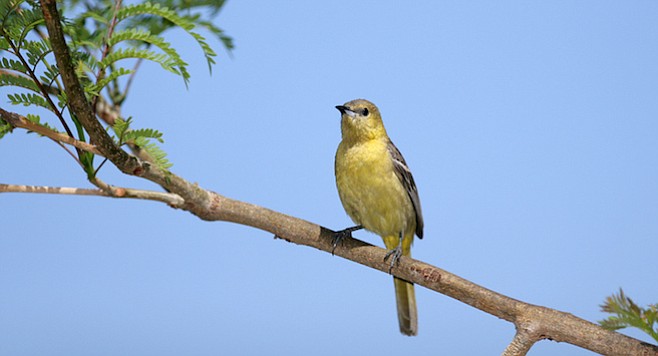 Facebook
Facebook
 X
X
 Instagram
Instagram
 TikTok
TikTok
 Youtube
Youtube

Orioles, the bright yellow or yellow-orange-and-black birds seen flitting among the palm trees, are summer residents of San Diego County's coastal areas. A century ago, the orioles preferred to nest in sycamore trees, which were then more common in our area's riser bottoms. Today these birds are most likely to take up residence in the planted palm trees, where they obtain fiber to build their nests from the easily shredded fronds.
Fleas, the bane of pets and humans alike, are hopping all over San Diego again as the summer progresses. This year is predicted to be worse than usual because of our greater-than-average precipitation last season, and because of the predicted higher-than-average summer temperatures and humidity. Fleas were even more troublesome in San Diego County's past than they are today. Soldiers on the Portola expedition over two centuries ago named a deserted Indian village in today’s North County "Rancheria de las Pulgas” and the problem of pulgas (“fleas') in the dusty streets and dwelling places of southern California were commonly mentioned in 19th-century journals and diaries. The place-names Las Pulgas Canyon and Las Pulgas Road in Camp Pendleton are reminders of a timeless torment.


Orioles, the bright yellow or yellow-orange-and-black birds seen flitting among the palm trees, are summer residents of San Diego County's coastal areas. A century ago, the orioles preferred to nest in sycamore trees, which were then more common in our area's riser bottoms. Today these birds are most likely to take up residence in the planted palm trees, where they obtain fiber to build their nests from the easily shredded fronds.
Fleas, the bane of pets and humans alike, are hopping all over San Diego again as the summer progresses. This year is predicted to be worse than usual because of our greater-than-average precipitation last season, and because of the predicted higher-than-average summer temperatures and humidity. Fleas were even more troublesome in San Diego County's past than they are today. Soldiers on the Portola expedition over two centuries ago named a deserted Indian village in today’s North County "Rancheria de las Pulgas” and the problem of pulgas (“fleas') in the dusty streets and dwelling places of southern California were commonly mentioned in 19th-century journals and diaries. The place-names Las Pulgas Canyon and Las Pulgas Road in Camp Pendleton are reminders of a timeless torment.
Comments